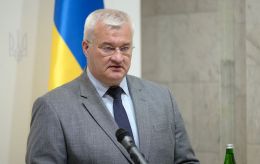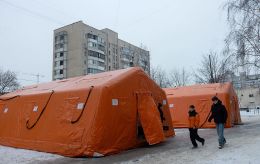Sarmat, Zircon, and Burevestnik: What's known about Putin's 'one-of-a-kind' weapons
 Russian dictator Vladimir Putin again threatens the West with nuclear weapons (Photo: kremlin.ru)
Russian dictator Vladimir Putin again threatens the West with nuclear weapons (Photo: kremlin.ru)
Russian dictator Vladimir Putin today, February 29, delivered an address, part of which was devoted to renewed threats. In particular, he mentioned specific types of weaponry for strikes on the territory of Western countries.
More about this and why Putin is threatening with weapons, including those that do not yet exist, read in the material by RBC-Ukraine.
The article was prepared using: Putin's address to the federal assembly, Wikipedia, material by the Center for Strategic and International Studies (CSIS), specialized portals Army Recognition, 19fortyfive.com, Defense Express, comments by military expert Oleksandr Kovalenko.
Content
- What and why is Putin threatening Western countries again?
- Fast and heavy: What is known about the Avangard missile complex
- Sarmat is a problematic missile and the longest-range on paper
- Nuclear Burevestnik: The essentials about a missile that doesn't exist yet
- Great torpedo Poseidon, which is unlikely to be deployed in the near future
- Laser Peresvet still under doubt
What and why is Putin threatening Western countries again?
Russian dictator Vladimir Putin today, February 29, delivered an address, part of which involved renewed threats. Specifically, he mentioned the strategic nuclear forces of Russia being "in a state of full readiness for guaranteed use."
"Thus, the hypersonic aviation complex Kinzhal is not only deployed but also effectively used for striking targets during special military operations," he said.
During the invasion of Ukraine, Russian forces have been employing Kinzhal without the nuclear warhead since March 2022, launching it from the MiG-31K carrier. The first such missile was shot down only in May 2023. The Soviet-era air defense systems could not effectively destroy ballistic targets. After Western air defense systems, including the Patriot, replaced them, according to the Air Force, 25 aeroballistic Kinzhal missiles were shot down by February 24, 2024.
Putin then practically confirmed strikes with the anti-ship Zircon.
"Also, in combat, the sea-based hypersonic strike complex Zircon has already been employed, which was not even mentioned in the 2018 address. But this system is also operational," he said.
This refers to the missile strike on Kyiv on February 7.
As stated by experts at the Institute of Forensic Expertise, Russia did indeed employ the 'Zircon.' Its claimed characteristics: range - 600-15000 km, speed - up to 8-9 Mach, warhead mass - about 300-400 kg, length - 8-10 m. Analysis of the fragments is complicated due to the significant fragmentation of the missile, but experts concluded that the weapon does not correspond to the stated characteristics.
For more details about the strike on February 7 and this missile, read a separate article by RBC-Ukraine.
 Photo: Vladimir Putin boasted about striking Ukraine with Zircons and Kinzals (kremlin.ru).
Photo: Vladimir Putin boasted about striking Ukraine with Zircons and Kinzals (kremlin.ru).
Putin didn't stop at Kinzals and Zircons and named several more types of weapons.
"Hypersonic intercontinental Avangard combat units and Peresvet laser complexes are on combat duty. Trials of the long-range cruise missile Burevestnik and unmanned underwater vehicle Poseidon are nearing completion. These systems have confirmed their high serial characteristics. The first serial heavy ballistic missiles Sarmat have been delivered to the troops. We will soon demonstrate them in deployment areas," he stated.
The Russian dictator emphasized purported readiness for a dialogue on strategic stability with the US but complained that Washington is engaged in "open hostile actions" and seeks to inflict strategic defeat on Moscow on the battlefield. He also touched upon the words of French President Emmanuel Macron, who recently did not rule out sending Western troops to Ukraine in the future.
"But we remember the fate of those who once directed their contingents to the territory of our country (obviously, Putin referred to Ukraine as 'our country' - Ed.). But now the consequences for possible interveners will be much more tragic. They must finally understand that we also have weapons that can strike targets on their territory. And that everything they terrify the world with, that all this poses a real threat of conflict involving the use of nuclear weapons, and thus the destruction of civilization," added Putin.
Fast and heavy: What is known about the Avangard missile complex
The Avangard is a missile complex equipped with a guided combat unit. It's worth noting that Russia is developing three hypersonic weapon programs, and the Avangard is the third after the Kinzhal and Zircon.
The core of the system is a hypersonic combat unit launched by the intercontinental ballistic missile UR-100N UTTX/RS-28 (to be replaced by Sarmat). In 2018, Putin stated that the maneuverable hypersonic warhead is capable of penetrating prospective missile defense systems by maneuvering in altitude and course. It approaches its target like a "fireball," with surface temperatures reaching up to 2000 degrees.
It has a complex of anti-missile defense means, with a probable length of 5-7 meters, a composite material body, and a control system allowing for changes in flight tasks and target allocation before launch. It supposedly reaches speeds of up to 28 Mach - around 9.5 km/s. Its range exceeds 6000 km, with a mass of about 2000 kg. The unit is equipped with a nuclear or conventional warhead with a power of 2 megatons.

Photo: Avangard missile complex (mil.ru)
The carrier rocket delivers it to a suborbital altitude of about 100 km, after which the Avangard transitions into cruising mode, re-enters the atmosphere, and accelerates to maximum speeds. It is claimed that the unit is capable of maneuvering and changing trajectory, making interception difficult. According to various estimates, it may take at least 50 SM-3 anti-missiles from the US Navy to intercept it. It's worth noting that in 2008, such a missile shot down a reconnaissance satellite at an altitude of 247 km and a speed of 22 Mach.
"The development of such weapons may not give America's adversaries a significant advantage, however. Should U.S. nuclear launchers, ICBMs or even land-launched, nuclear-armed strategic bombers be rendered ineffective or destroyed, the United States still has available options with which to retaliate; including measures via the U.S. Navy’s nuclear-armed ballistic missile submarines," wrote military expert Peter Suciu in a column for The National Interest.
The first Avangards were deployed in 2019. As of the end of 2023, Russia reportedly had approximately 18 units (three missile regiments with 6 units each) in the Orenburg division.

